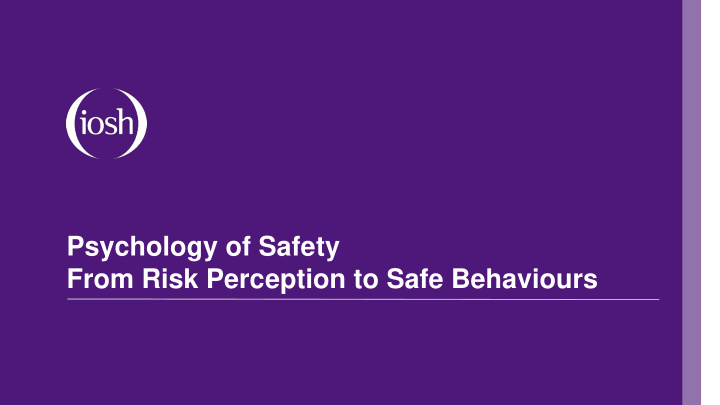



Psychology of Safety From Risk Perception to Safe Behaviours
State of mind and risk perception Influencers and modifiers Tina Balachandran Consultant Psychologist
Declaration - I am an employee of Qatar Airways - I have no potential conflicts of interest to report - Opinions expressed are my own and do not directly represent the opinion of the organization
Objectives - Examine factors that shape perception and tolerance of risk - Understand the internal factors that impact safe behaviour - Discuss practical applications and possible solutions
Spot the hazard
Psychology of Safety Risk Management - Shaping our Perception - Research related to OHS has focused on the management of worker safety with little concern for the subjective interpretation of safety risks and effects (Morrow & Crum, 1998) - Safety interventions need to consider risk perception and reduce the level of risk people are willing to tolerate in order to be successful. - Improvements in OHS cannot be achieved through training, engineering or enforcement - The extent of risk taking ultimately depends on the values that prevail, not the safety technology available.
Perception of risk Not constant. Varies with individual and context Ref: Deloitte, Enterprise Risk Services
Impact of mood on safety behavior
Memory and experience on safety behavior - Memory trials and research has demonstrated that: - Big picture vs. details - Suggestion and prompting - Forget unpleasant events - Perception of an event impacts memory - Interruptions whilst learning or retrieving information can lead to errors in mental processing - Perception of risk is also influenced by prior experience
Human performance and accidents Human performance approach to accident causation Error traps - • Time pressure • Mental pressure • Fatigue • New to the task • Distractions • Overconfidence Ref: US Dept. of Energy, 2009
Stress impact on safety behaviour A collective challenge Physical Psychological Behavioural Warning Signs: • Difficulty concentrating • Lack of motivation • Emotional exhaustion • Feeling guilty Ref: ILO, 2016
Making a decision to be safe Link between risk perception and behaviour - Risk perception is a critical antecedent to at-risk behaviour - Direct pressure, high stress, persuasive leaders, cohesiveness, shared stereotypes can encourage groupthink and can lead to a failure to examine risks, poor information gathering, bias in information processing and perception.
Practical applications
Are we in the right state of mind?
Impact of organizational factors Can they be protective factors? Clear Recognition & Organizational Leadership & Culture Reward Expectations Growth & Psychological Development Support Workload Involvement & Balance & management Influence Engagement
Conclusion Incorporate the human element into risk management Address the psychological hazards - Need to focus on the human aspect and individual differences - Consider the internal and external factors that influence safe behaviours - Improve workplace morale and motivation - Early access to mental health support services - Focus on employee engagement and wellbeing
Questions? Its OK to talk tina.narotra@gmail.com
Recommend
More recommend